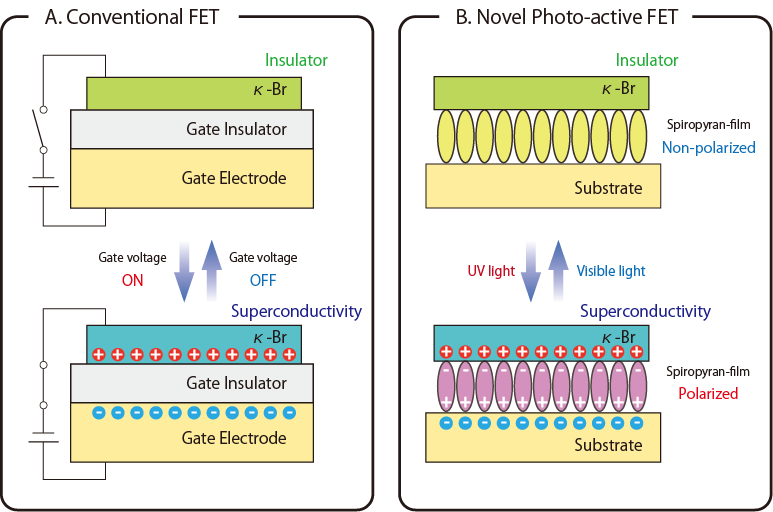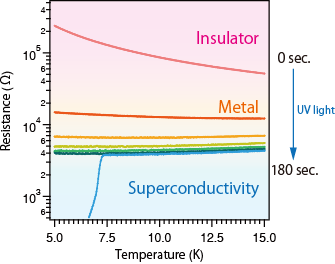A research team led by Prof. Hiroshi M. Yamamoto of the Institute for Molecular Science, National Institutes of Natural Sciences has developed a novel superconducting transistor which can be switched reversibly between ON and OFF by light-irradiation. This achievement is a milestone for future high-speed switching devices or highly-sensitive optical sensors.
The field-effect transistor (FET) is a basic switching element that controls electrical current in electronic circuits. FETs are currently included in a variety of electronic devices such as smart phones and computers. In recent years, much effort has been devoted to develop a superconducting FET as a key technology for computations using quantum states.
In 2013, the research team developed the world's first organic superconducting FET based on the organic superconductor: κ-(BEDT-TTF)2Cu[N(CN)2]Br (κ-Br). Their previous work has allowed the organic superconducting FET to be recognized again as having inherent advantages such as flexibility and designability.
In this research, the team fabricated a novel photo-switchable transistor by replacing the gate electrode in the conventional FET with a ‘spiropyran’-thin-film as shown in Figure 1. When Dr. Masayuki Suda, a member of the research team, shone a pale UV light on this novel FET, it showed a rapid decrease of electrical resistance and turned into a superconducting state after 180 seconds. (Figure 2) Spiropyran is a photo-active organic molecule that shows intra-molecular electrical polarization by UV light irradiation. In this system, carriers for the superconductivity can be accumulated by UV light-induced electrical polarization of the spiropyran-film. Dr. Suda also found that the device can be switched to the superconducting state both by gate-voltage control and light-irradiation control. Such a multi-mode operation obtained by combining two kinds of functional molecules, BEDT-TTF and spiropyran, indicates the high designability of organic systems. The superconductivity could also be removed by visible light-induced depolarization of the film.

Figure1: Configurations of the conventional FET (A)
and the novel photo-active FET (B)

Figure 2: Temperature dependence of the resistance after various UV
irradiation times.
This research presents a novel concept in which “superconductivity can be switched by optical stimuli,” and will drive innovation in the field of future high-speed switching devices or high-sensitivity optical sensors. “Now it takes 180 seconds to switch the FET, but it can be operated much faster in principle,” said Dr. Suda, “and it will open a way to a new type of devices that can satisfy glowing demand for a high-speed information infrastructure.”
Glossary
1) Superconductivity
Superconductivity is a phenomenon in which materials lose all electrical resistance at low temperature. Superconducting materials are used in some applications such as cables for electrical transport or strong electrical magnets for NMR/MRI machines.
2) Spiropyran
A spiropyran is a type of photochromic molecule. Photochromism is the phenomenon that shows color changes by light irradiation. Spiropyran can photoisomerize reversibly between the nonionic closed-ring form and the zwitterionic open-ring form upon UV and visible light irradiation.
3) Visible light, Ultraviolet (UV) light
Light has wave properties. Sunlight or fluorescent light actually consists of many wavelength of light. Among them, light having wavelengths from ca. 10 - 400 nm is called ultraviolet light and from ca. 400 - 800 nm is called visible light.
Information of the paper
Journal: Science
Title: Light-induced superconductivity using a photo-active electric double layer
Authors: Masayuki Suda, Reizo Kato, Hiroshi M. Yamamoto
Date: 2015/2/13
Research Group
This work was performed by a collaboration between Dr. Masayuki Suda (Assistant professor) and Dr. Hiroshi M. Yamamoto (Professor) of the Institute for Molecular Science, National Institutes of Natural Sciences and Dr. Reizo Kato (Chief Scientist) of RIKEN.
Financial Supports
Grant-in-Aid for Scientific Research: No. 22224006, No. 25810143
Contact
Masayuki Suda
Assistant professor, Research Center of Integrative Molecular Systems (CIMoS), Institute for Molecular Science
TEL (FAX): +81-564-55-7347 (7325)
E-mail: msuda_at_ims.ac.jp
Hiroshi M. Yamamoto
Professor, Research Center of Integrative Molecular Systems (CIMoS), Institute for Molecular Science
TEL (FAX): +81-564-55-7334 (7325)
E-mail: yhiroshi_at_ims.ac.jp
1126
1049


